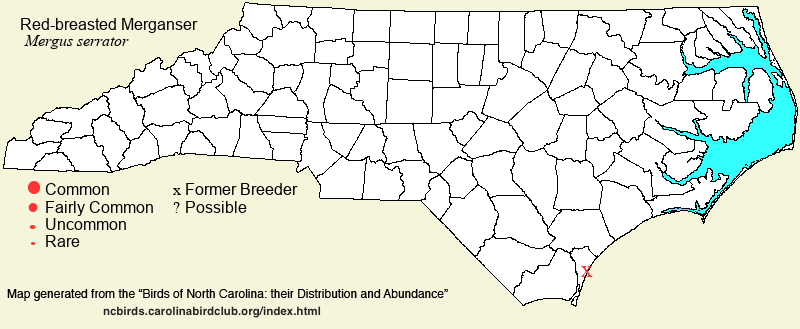 |  |
|
Red-breasted Merganser - Mergus serrator ANATIDAE Members: | Search Common: Search Scientific: |
|
|
|||||||
| General Comments | The Red-breasted Merganser is one of the state's most common wintering waterfowl species, it being easily found in coastal areas and often in large numbers. A handful linger all summer near and along the coast, and it has bred there conclusively once or twice. Unlike the other two mergansers, it favors brackish and salt water habitats, occurring in flocks of hundreds to thousands on sounds (especially Pamlico Sound), bays, and embayed rivers; some also winter on the ocean. However, smaller numbers also frequent fresh water impoundments, lakes, and ponds, usually for short periods of time, both inland and coastally. In fact, it typically outnumbers the similar Common Merganser on inland lakes in migration and as winter visitors. | ||||||
| Breeding Status | Accidental Breeder | ||||||
| NC BRC List | Definitive | ||||||
| State Status | |||||||
| U.S. Status | |||||||
| State Rank | S5N | ||||||
| Global Rank | G5 | ||||||
| Coastal Plain | Winter resident, and accidental breeding resident. Common to locally abundant in the Tidewater and north coastal zones; common to very common along the southern coast. Some of the continent's largest wintering concentrations (often the national CBC high count) occur on Pamlico Sound, where tens of thousands spend the winter season. On lakes, ponds, and impoundments, the species is mainly a short-term visitor, and it is mostly an uncommon migrant and winter visitor farther inland. Can be occasionally numerous on Phelps Lake (Washington) in the Tidewater region; one wonders if the tally of 739 there on a CBC on 27 Dec 2019 included some to many of the Common Mergansers that routinely winter there in large numbers. Generally early Oct to late May, with many records all summer long. An immature with some down feathers was seen at Wrightsville Beach, 28 Jun 1967. Peak count: 150,000, Pamlico Sound, 9 Jan 1981. | ||||||
| Piedmont | Transient and winter visitor. Rare to occasionally uncommon in fall and winter, and uncommon in spring migration, especially in Mar and early Apr. A flurry of dozens of birds was noted on lakes in the province in Feb 2014. Occurs mainly on larger reservoirs, but females may occur on ponds and smaller lakes. Mainly late Oct to early May. Peak counts: 149, Lake Townsend (Guilford), 10 Mar 2014; 100+, Lake Townsend, 25 Feb 2014; 100, Lake Wheeler (Wake), 30 Mar 1977; 75, Lake Crabtree (Wake), 12 Dec 2012. | ||||||
| Mountains | Transient and winter visitor. Rare to occasionally uncommon in fall and winter, but more frequent (uncommon) in spring. Most records are from the lower elevations in the southern mountains (Buncombe, Henderson, and Transylvania). Mainly early Nov to early May. Peak counts -- all from 6 Dec 2016: 114, Lake Junaluska (Haywood); 100+, Lake Julian (Buncombe); 75, at a wastewater treatment plant along NC 191 (Henderson). Other high counts: 109, Lake Summit (Henderson), 10 Dec 2024; 100, Lake Julian, 14 Dec 2022; 86, Lake Junaluska, 20 Nov 2024. | ||||||
| Finding Tips |
The species is practically impossible to miss in a day of birding around salt or brackish water in winter. Many thousands winter in the middle of Pamlico Sound and can be seen from the Swan Quarter ferry. It is often the most common duck on coastal CBC's; seldom does such a count miss this species. Inland, it is best to search large lakes in migration, such as in Nov and from late Mar to mid-Apr. **** | ||||||
| Attribution | LeGrand[2025-05-07], LeGrand[2025-01-29], LeGrand[2023-05-17] | ||||||
| NC Map Map depicts all counties with a report (transient or resident) for the species. | Click on county for list of all known species. |
| NC Breeding Season Map Map depicts assumed breeding season abundance for the species. |  |